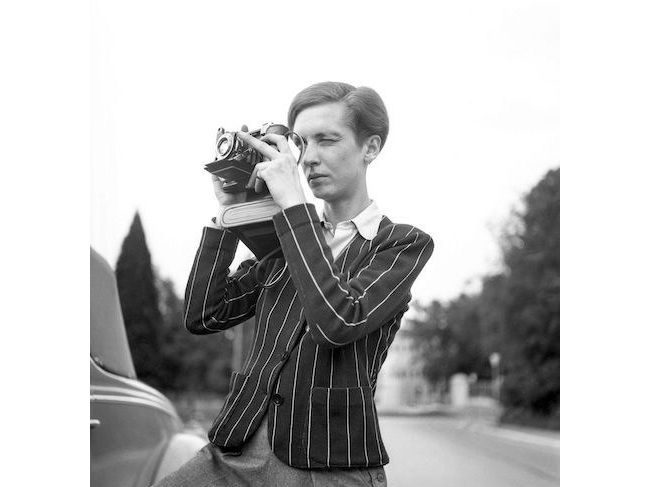Categories more
- Adventures (16)
- Arts / Collectables (14)
- Automotive (36)
- Aviation (10)
- Bath, Body, & Health (73)
- Children (6)
- Cigars / Spirits (30)
- Cuisine (16)
- Design/Architecture (17)
- Electronics (12)
- Entertainment (4)
- Event Planning (3)
- Fashion (43)
- Finance (8)
- Gifts / Misc (6)
- Home Decor (44)
- Jewelry (39)
- Pets (3)
- Philanthropy (1)
- Real Estate (11)
- Services (21)
- Sports / Golf (14)
- Vacation / Travel (60)
- Watches / Pens (14)
- Wines / Vines (24)
- Yachting / Boating (15)
Published
05/06/2022 by Bechtler Museum of Modern ArtWriter, journalist, photographer, traveler, cosmopolitan and fashion icon Annemarie Schwarzenbach (1908-1942) was one of the most dazzling and contradictory figures in modern Swiss cultural history. Consumed by wanderlust, a desire for social progress, and a sense of adventure, Schwarzenbach traveled extensively through Europe, Central Asia, Central and North Africa, and the United States between 1933 and her death in 1942. While Schwarzenbach saw herself primarily as a writer, she was a pioneer of photojournalism in Switzerland. Her work as a journalist, coupled with her upper-class background and her status as the wife of French diplomat Claude Clarac granted her extraordinary freedom of travel for the period.
Annemarie Schwarzenbach: Departure Without Destination, presented in collaboration with Zentrum Paul Klee in Bern, Switzerland, is the first major retrospective dedicated to the photography of Annemarie Schwarzenbach. The Bechtler Museum of Modern Art presents the U.S. premier of Schwarzenbach's work, on display through June 19, 2022. Curated by Martin Waldmeier with the Zentrum Paul Klee, this exhibition features archival material, film, and 200 photographs drawn from the approximately 7,000 photographs in the estate of Annemarie Schwarzenbach, which is held in the Swiss Literary Archives in Bern, Switzerland.
Schwarzenbach was born in 1908 into the affluent Schwarzenbach-Wille family of Zurich industrialists and graduated with degrees in history in Zurich and Paris. Because of her political and sexual orientation, she turned her back on her conservative family and established connections with the German literary diaspora, particularly with the siblings Klaus and Erika Mann. In 1931 she lived in Berlin before moving, after the National Socialist seizure of power, to Spain, Russia and Iran, where she published prose and journalistic writings.
Despite her years-long struggle with drug dependency, over the course of the 1930s, Schwarzenbach professionalized herself as a travel and features journalist. On joint trips with female writers and photographers such as Ella Maillart, Marianne Breslauer and Erika Mann, she turned her attention to social and political subjects, including the rise of National Socialism, the workers' movement in the United States, the consequences of modernization and the role of women in society. Her photographs, though, also reveal a longing for foreign lands and the poetry of travel. Some 300 articles by Schwarzenbach were published in Swiss magazines and newspapers in her lifetime. From 1933 these articles were increasingly accompanied by her own pictures, although most of Schwarzenbach's photographs remained unpublished before her death at the age of 34.
"Annemarie Schwarzenbach was multi-talented – as a writer, journalist and photographer – in a time when few women were represented in these fields," said Bechtler Museum of Modern Art Executive Director Todd D. Smith. "The dialogue that unfolds between Schwarzenbach's texts and photographs opens our eyes to the upheavals and conflicts of the 1930s. At the same time, Schwarzenbach's documentary viewpoint explores themes in a poetic and astonishingly contemporary way."
When her literary work was rediscovered in the 1980s, Schwarzenbach became celebrated as a writer, female pioneer and gay icon. Her gender-bending fashion sense and her lifestyle were the inspiration for Clare Waight Keller's Spring/Summer 2019 line for the fashion house Givenchy.
It was not until recently that Schwarzenbach's contributions to photography have been recognized. Her images and writings are closely intertwined and document the upheavals, tensions and conflicts of the period leading up to World War II. Schwarzenbach's photographs also convey private themes, such as life in exile, the search for identity, homosexuality and the desire to transgress conventional gender roles. Above all, though, the photographs express Schwarzenbach's unbridled passion for travel – and her search for encounters with the unknown, the "departure without destination" as an existential experience. The exhibition title 'Departure Without Destination' refers to the life of Annemarie Schwarzenbach, which was characterized by a great restlessness, homelessness, deracination, departure, and a search for hope in foreign countries. These themes run like a thread through her writings and her photographic work and connect the work with the literary tradition of the modern age.















